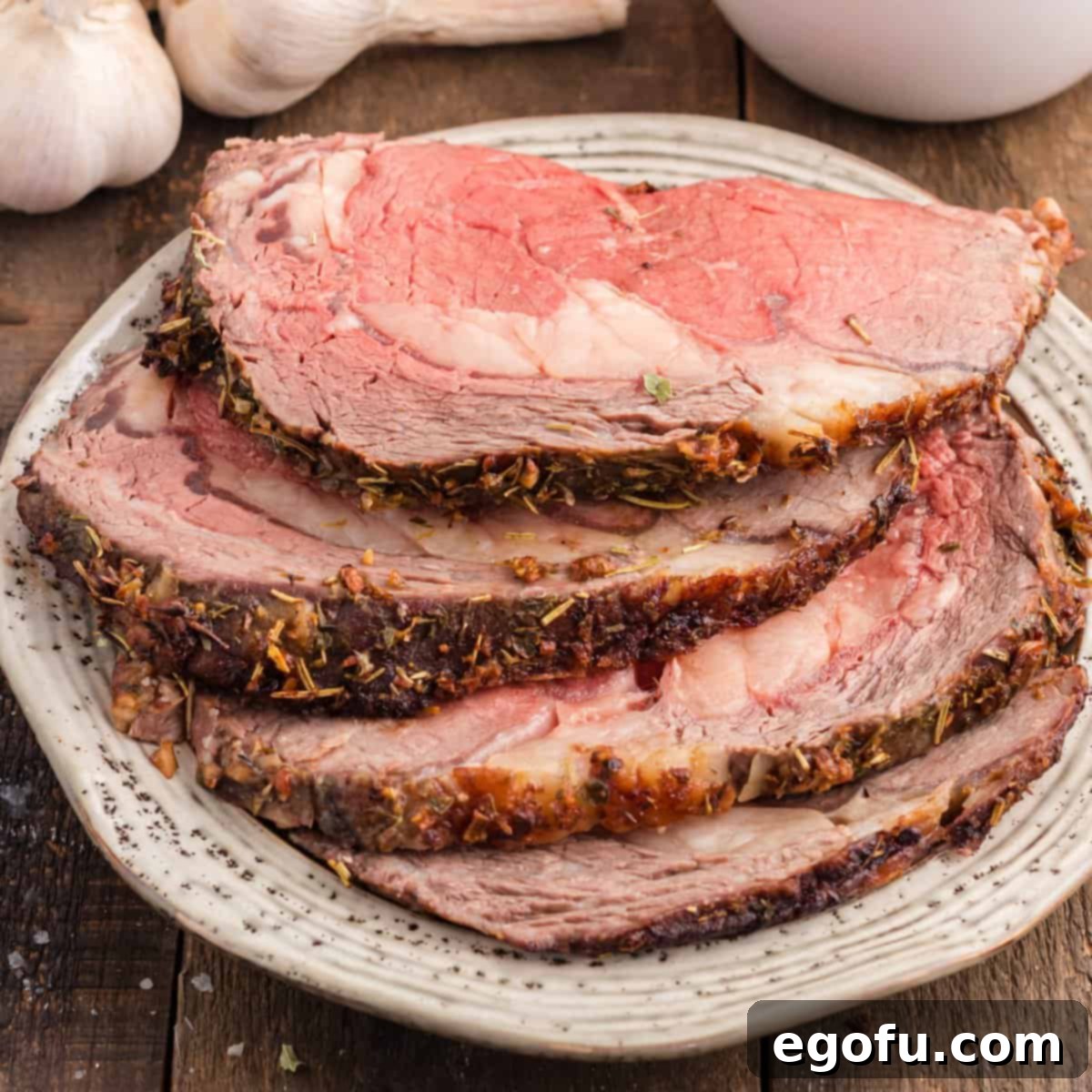This Garlic Butter Prime Rib recipe, featuring a delectable herb crust and rich au jus, is surprisingly simple to prepare, promising a truly special and delicious holiday dinner!
Garlic Butter Prime Rib: An Elegant, Yet Effortless Holiday Dinner
Imagine a holiday meal that’s both breathtakingly elegant and surprisingly easy to execute. Our Garlic Butter Prime Rib recipe delivers exactly that, making it the perfect centerpiece for your festive table or any special occasion. For years, this recipe has been my trusted choice for Christmas dinner, consistently yielding melt-in-your-mouth beef encased in a golden, buttery, herb-infused crust. Paired with a savory homemade au jus (recipe included!), this dish elevates any gathering into a memorable culinary experience. Don’t let the grandeur of prime rib intimidate you; this guide is designed to be foolproof, ensuring even novice cooks can achieve perfection. Plus, the tender leftovers make for incredible sandwiches, extending the enjoyment! If you’re seeking a reliable and utterly delicious prime rib recipe, look no further than this Garlic Butter Prime Rib.

Why This Garlic Butter Prime Rib Recipe Stands Out
There are countless prime rib recipes out there, but this garlic butter rendition holds a special place for its unparalleled flavor and user-friendly approach. The secret lies in the aromatic garlic and herb butter, which not only forms a magnificent crust but also permeates the meat with incredible depth. This recipe emphasizes precise temperature control and strategic resting, two crucial factors often overlooked that guarantee a uniformly cooked, juicy roast every time. Whether you’re a seasoned chef or embarking on your first prime rib adventure, this guide simplifies the process without compromising on gourmet results. It’s more than just a meal; it’s an experience, turning an ordinary dinner into an extraordinary celebration. Prepare to impress your family and friends with a prime rib that’s not only visually stunning but also incredibly flavorful and tender.
Frequently Asked Questions About Prime Rib
When you head to the grocery store or butcher shop, prime rib might go by a few different names. The most common terms to look for are “Prime Rib Roast,” “Standing Rib Roast,” or simply “Rib Roast.” Sometimes it might even be labeled as “Bone-in Rib Roast” or “Boneless Rib Roast.” These cuts are typically found in the fresh beef section, often near other premium cuts. Don’t hesitate to ask your butcher for assistance; they can help you select the perfect roast for your needs and even prepare it by cutting and reattaching the bones, which is a highly recommended step for optimal results.
Prime rib, as its name suggests, comes from the primal rib section of the cow. This area, located at the top-middle part of the cow’s back, is renowned for its tenderness and rich flavor. The muscles in this region are not heavily used, resulting in a naturally tender cut compared to more worked areas like the shoulder or leg. Furthermore, the rib section boasts excellent marbling – the intramuscular fat that melts during cooking, infusing the meat with incredible juiciness and a profound beefy flavor. This combination of natural tenderness and rich marbling is what makes prime rib such a highly prized and delicious cut of beef, perfect for slow roasting to perfection.
While prime rib roasts and ribeye steaks originate from the same primal rib section of the cow, they are indeed distinct cuts and are prepared differently. A prime rib is typically a larger roast, often containing multiple bones, and is designed for slow roasting. It offers a more expansive piece of meat with a generous fat cap and marbling throughout. Ribeye, on the other hand, is a steak cut from the rib section, usually smaller and can be either bone-in or boneless. Because of their differing sizes and forms, they cook up with slightly different textures and require unique cooking methods to achieve their optimal flavor profiles. Think of prime rib as the whole magnificent roast, and a ribeye as an individual, often thicker, slice designed for quicker searing or grilling.
When it comes to prime rib, bone-in is often preferred for several excellent reasons, though boneless certainly has its conveniences. If you have the opportunity, ask your butcher to cut the bones away from the roast and then reattach them to the bottom. This clever trick provides several benefits: the bones act as a natural roasting rack, allowing heat to circulate more evenly around the roast for consistent cooking. They also impart additional flavor to the meat during the roasting process. After cooking, these bones can be easily removed before carving and are fantastic for making rich soups, bone broth, or beef broth, adding another layer of culinary delight. If this butcher service isn’t available, a sturdy V-rack in your roasting pan will achieve similar results for even heat distribution. While boneless is easier to carve, bone-in often yields a more flavorful and evenly cooked roast.
Cooking time for prime rib varies greatly depending on the size of your roast and your desired level of doneness. The most critical tool here is a reliable oven-safe probe thermometer. Remember that your roast will continue to cook, increasing in temperature by about 5-10 degrees Fahrenheit, even after it’s removed from the oven – this is known as carry-over cooking. For prime rib, medium-rare to medium is generally recommended as the optimal doneness to highlight its tender texture and rich flavor. Here’s a handy guide for when to remove your roast from the oven based on your preferred final temperature:
- Remove roast at 110-115°F for rare (final temperature around 120-125°F).
- Remove roast at 120-125°F for medium-rare (final temperature around 130-135°F).
- Remove roast at 125-130°F for medium (final temperature around 135-140°F).
- Remove roast at 135-140°F for medium-well (final temperature around 145-150°F).
Always aim for the lower end of the removal temperature range if you prefer a juicier result, as you can always cook it longer, but you can’t uncook it!
Properly stored, prime rib leftovers are a treasure! Once cooled, transfer any remaining roast to an airtight container and store it in the refrigerator for 3-4 days. To reheat without drying out the meat, avoid the microwave, as it can make prime rib tough and rubbery. Instead, gently reheat slices in a 200-degree Fahrenheit oven, covered loosely with foil, until warmed through. Alternatively, you can warm slices in a buttered pan on the stovetop over medium-low heat. The goal is to bring it to a comfortable eating temperature without further cooking it. These perfectly tender leftovers are absolutely phenomenal for creating gourmet prime rib sandwiches, delicious beef tacos, or a hearty prime rib hash for breakfast!
A show-stopping prime rib deserves equally impressive accompaniments. Classic pairings include creamy mashed potatoes (like our suggested Crock Pot Million Dollar Mashed Potatoes), crisp green beans, or roasted asparagus. For a truly traditional feast, consider adding Yorkshire pudding, which is designed to soak up the rich au jus, or a decadent creamed spinach. Other excellent choices include roasted root vegetables (carrots, parsnips, potatoes), a fresh garden salad with a light vinaigrette to cut through the richness, or even a simple crusty bread to sop up every last drop of the delicious pan juices.

Essential Ingredients: Crafting Your Perfect Garlic Butter Prime Rib
Gathering the right ingredients is the first step to a magnificent prime rib. Our recipe uses a blend of fresh and dried herbs, combined with rich butter and savory beef drippings, to create layers of flavor that will impress every guest.
- Prime Rib Roast: The star of the show! A high-quality roast with good marbling is key for tenderness and flavor.
- Unsalted Butter: The base for our aromatic herb crust, providing richness and helping with that beautiful sear.
- Minced Garlic: Fresh garlic is indispensable for infusing deep, pungent flavor into the butter and the meat.
- Sea Salt & Black Pepper: Essential seasonings to enhance the natural beef flavor and form a delicious crust.
- Thyme, Rosemary, & Parsley Flakes: A classic herb trio that offers earthy, aromatic notes perfectly complementing the beef.
- Beef Drippings: Collected from the roasting pan, these are the flavor foundation for our exquisite au jus.
- All-Purpose Flour: Used to create a roux, thickening the au jus to a silky consistency.
- Beef Broth: The liquid base for the au jus, adding savory depth.
- Worcestershire Sauce: A secret weapon for umami, adding a subtle tangy, savory kick to the jus.
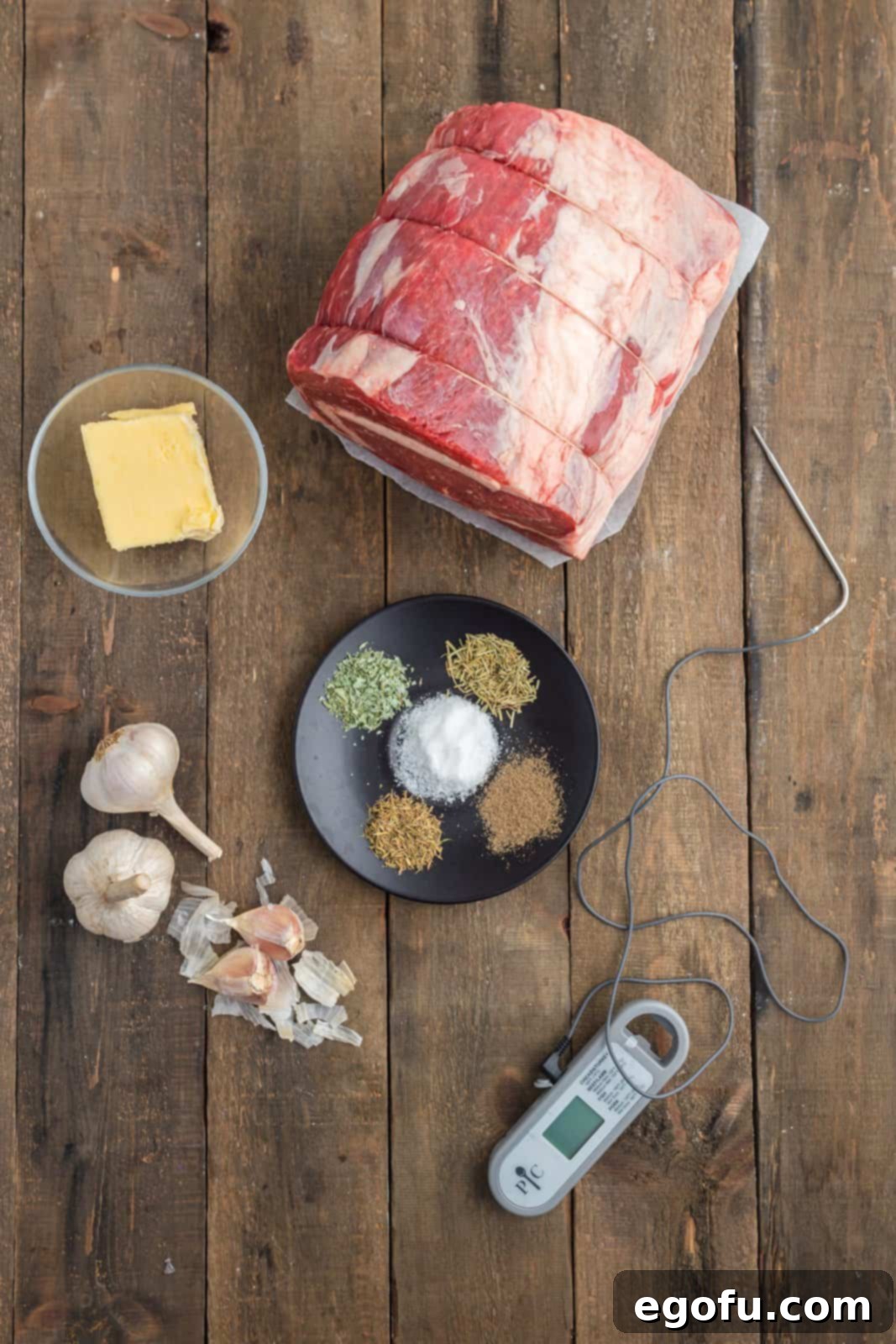
Step-by-Step Guide: How to Make the Best Garlic Butter Prime Rib
Follow these detailed steps carefully for a prime rib that’s perfectly cooked, incredibly tender, and bursting with flavor. Preparation is key to success!
Step 1: Bring to Room Temperature & Prepare the Roast
Remove your prime rib roast from the refrigerator 2-3 hours before you plan to cook it. Allowing the meat to come to room temperature is a crucial step for even cooking; a cold roast will cook unevenly, resulting in overcooked edges and a raw center. Once at room temperature, pat the entire roast thoroughly dry with paper towels. A dry surface is essential for achieving a beautiful, crispy crust. Place the pat-dried roast in a sturdy roasting pan. Set it aside while you prepare the aromatic garlic butter mixture. Begin by finely mincing about 5 cloves of fresh garlic on a cutting board, ensuring a consistent texture for even flavor distribution. Set the minced garlic aside.
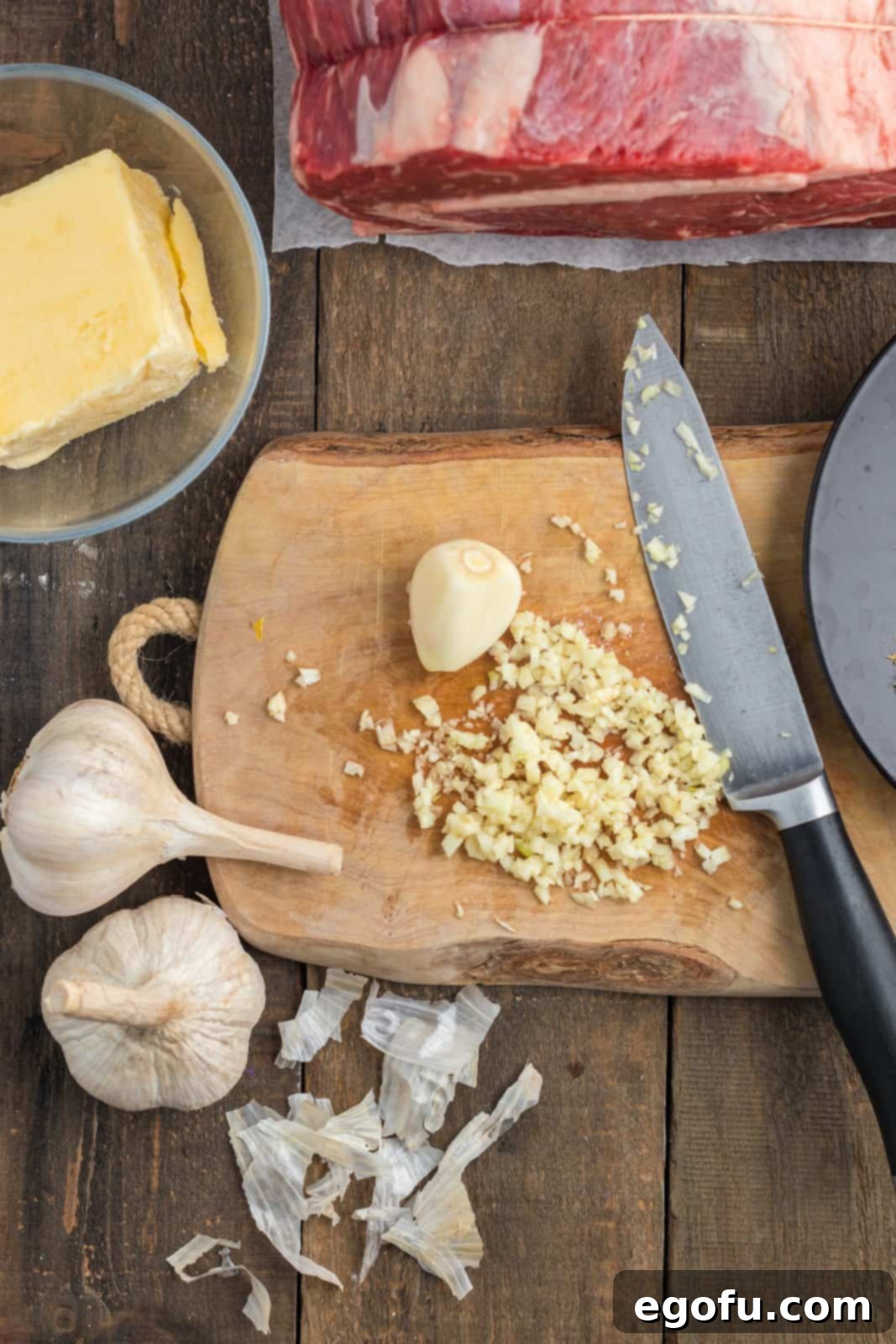
Step 2: Create the Aromatic Garlic Herb Butter
In a small mixing bowl, combine the softened unsalted butter with your finely minced garlic, sea salt, black pepper, dried thyme, dried rosemary, and dried parsley flakes. Use a spoon or small spatula to thoroughly mix all the ingredients until they are well incorporated and form a uniform paste. The butter should be at room temperature to ensure it mixes smoothly with the herbs and spreads easily over the roast.

Step 3: Apply the Herb Butter and High-Heat Sear
Preheat your oven to a blazing 500 degrees Fahrenheit. This initial high-heat blast is crucial for creating a beautiful, flavorful crust on the exterior of the prime rib, sealing in juices. Using your hands (wearing gloves is recommended) or a pastry brush, generously apply the garlic herb butter mixture all over the roast. Focus on building a thicker layer on the top of the roast, and a thinner, more even layer on the sides. Be mindful not to apply too much butter directly to the bottom of the pan, as excessive butter and garlic can drip and burn during the high-heat phase, potentially imparting a bitter flavor. Carefully place the prepared roast in the bottom third of your preheated oven and roast for exactly 15 minutes. This initial searing step is vital for developing the incredible crust.

Step 4: Slow Roast to Perfection with Temperature Control
After the initial 15 minutes at high heat, carefully remove the roast from the oven. Immediately lower the oven temperature to 325 degrees Fahrenheit. Now, it’s time for precise temperature monitoring: insert an oven-safe probe thermometer into the thickest part of the meat, ensuring the tip does not touch any bones, as this can give a false reading. Return the roast to the oven and continue cooking until the thermometer registers 120 degrees Fahrenheit. This internal temperature is ideal for achieving a perfectly medium-rare roast after resting. Refer to the FAQs or your personal preference for alternative doneness levels; remember the carry-over cooking effect.

Step 5: The Crucial Resting Period
Once your prime rib reaches the target internal temperature, remove it from the oven and transfer it to a clean cutting board. Tent the roast loosely with aluminum foil. This resting period is absolutely critical and should last for 20-30 minutes before you even think about carving. During this time, the internal temperature will continue to rise by several degrees (carry-over cooking), and more importantly, the juices within the meat will redistribute throughout the roast. Skipping this step will result in juices flowing out when carved, leading to a drier, less flavorful roast. A perfectly rested medium-rare prime rib will settle around 130 degrees Fahrenheit.

Step 6: Prepare the Rich Au Jus Gravy
While your magnificent prime rib is resting, it’s the perfect time to prepare the accompanying au jus. Skim any excess fat from the roasting pan, leaving behind the flavorful beef drippings. In a medium saucepan set over medium heat, melt 4 tablespoons of these beef drippings. Once melted, whisk in 2 tablespoons of all-purpose flour to create a rich roux. Continue whisking constantly for 1-2 minutes until the flour is fully incorporated and forms a thick, golden-brown paste. This roux will be the thickening agent for your luscious gravy.
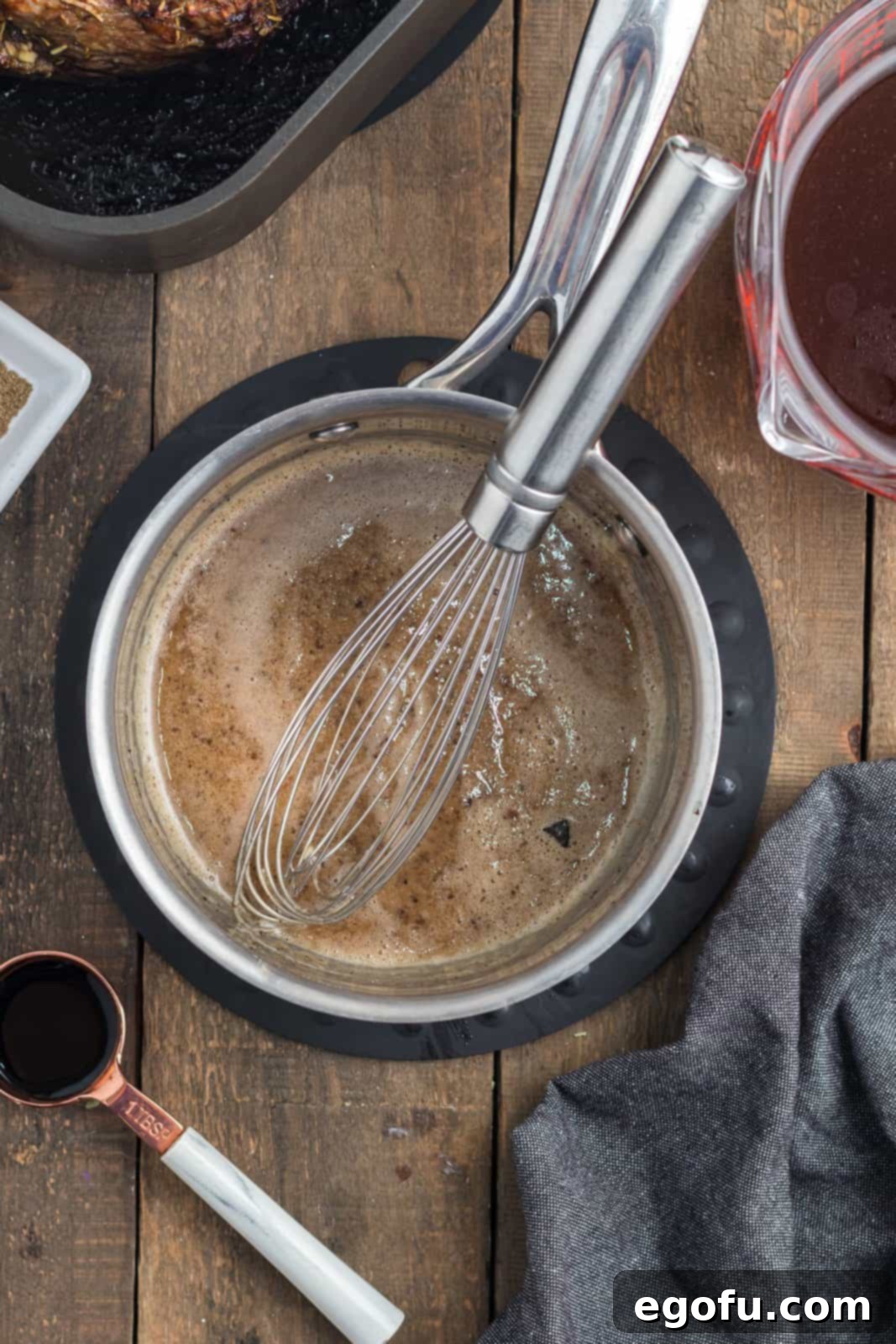
Step 7: Finish the Au Jus
Slowly pour in 2 ¼ cups of beef broth into the roux, whisking continuously to ensure a smooth, lump-free consistency. Bring the mixture to a gentle simmer, allowing it to cook for about 5 minutes, stirring occasionally, until it thickens slightly to your desired gravy consistency. Remove the saucepan from the heat and stir in 1 tablespoon of Worcestershire sauce, along with salt and pepper to taste. The Worcestershire sauce adds a wonderful depth of umami. Taste and adjust seasonings as needed.


Step 8: Carve and Serve Your Masterpiece
Once rested, transfer your glorious prime rib roast to a carving board. For maximum tenderness, it’s essential to slice the meat against the grain. This means cutting perpendicular to the long muscle fibers, which shortens them and makes each bite incredibly tender. Serve generous slices immediately, accompanied by the warm, savory au jus and your chosen side dishes. Prepare for rave reviews!
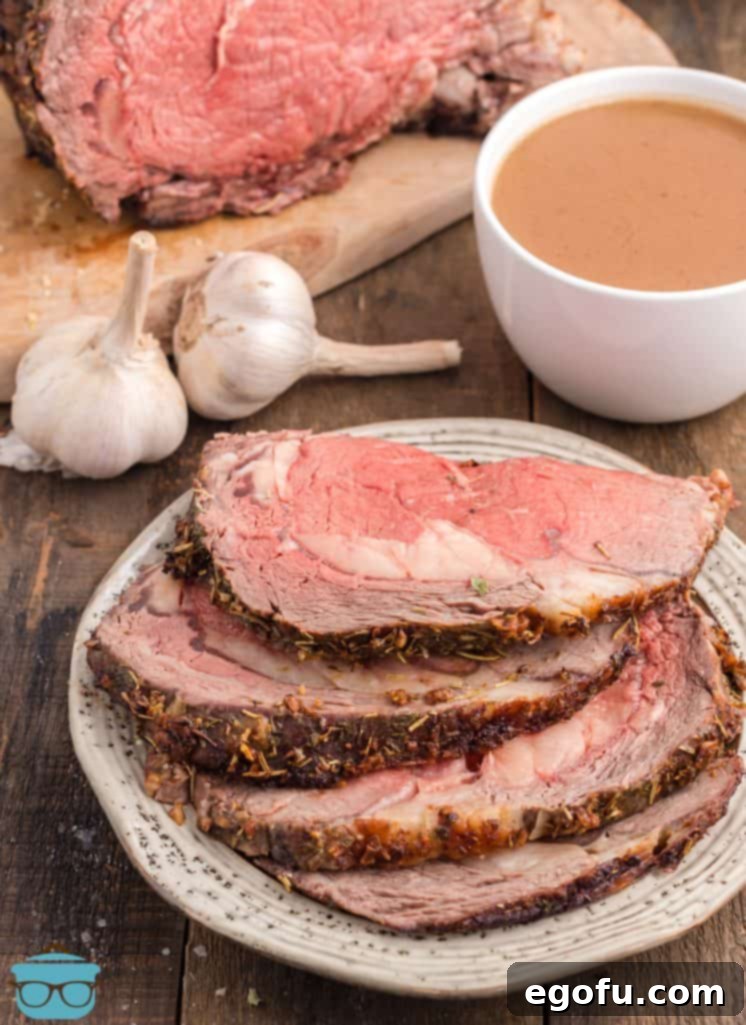
Serve with the rich au jus or any other favorite condiments and delicious side dishes that you enjoy!
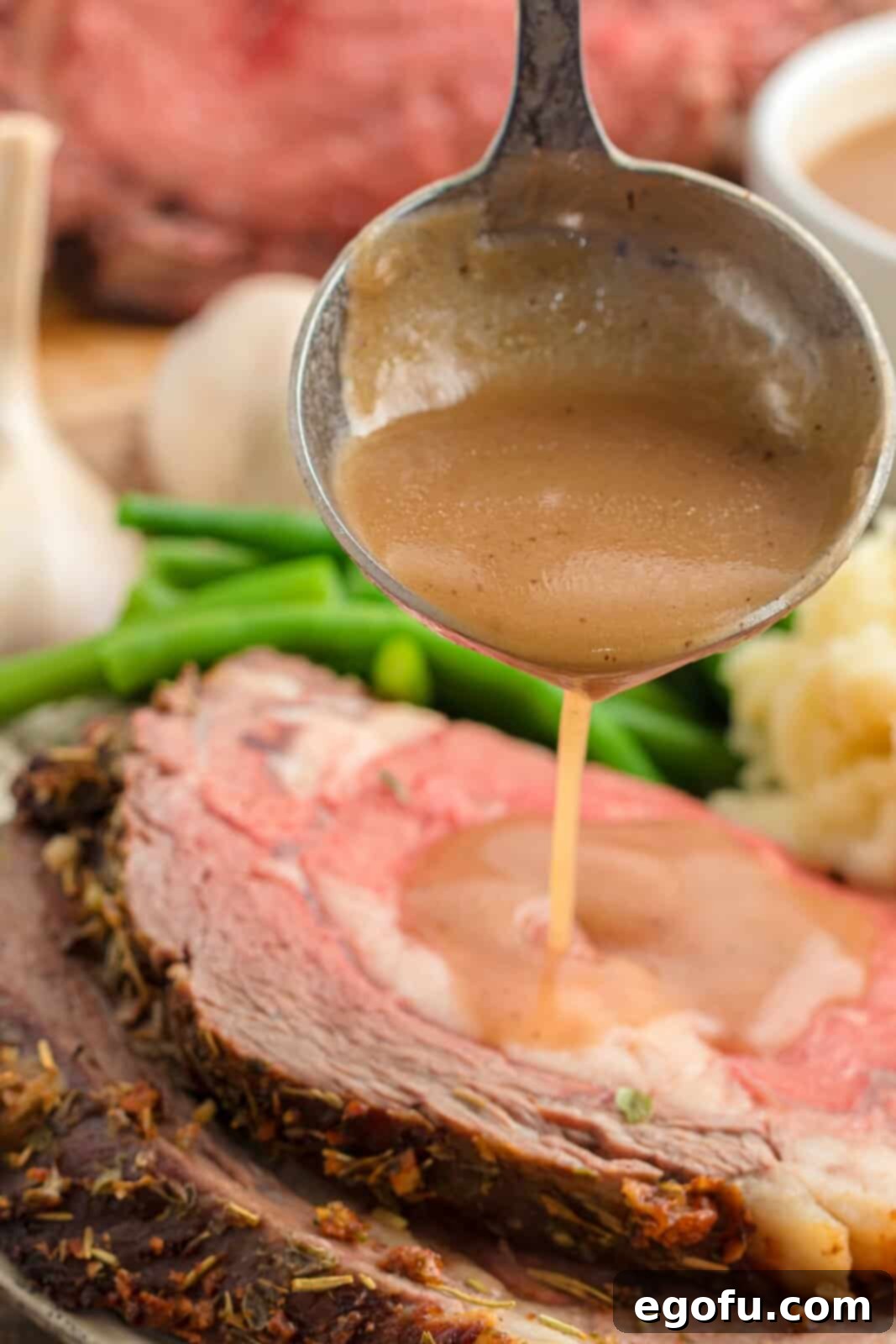
Served here with a side of creamy mashed potatoes and vibrant green beans, creating a complete and satisfying meal.
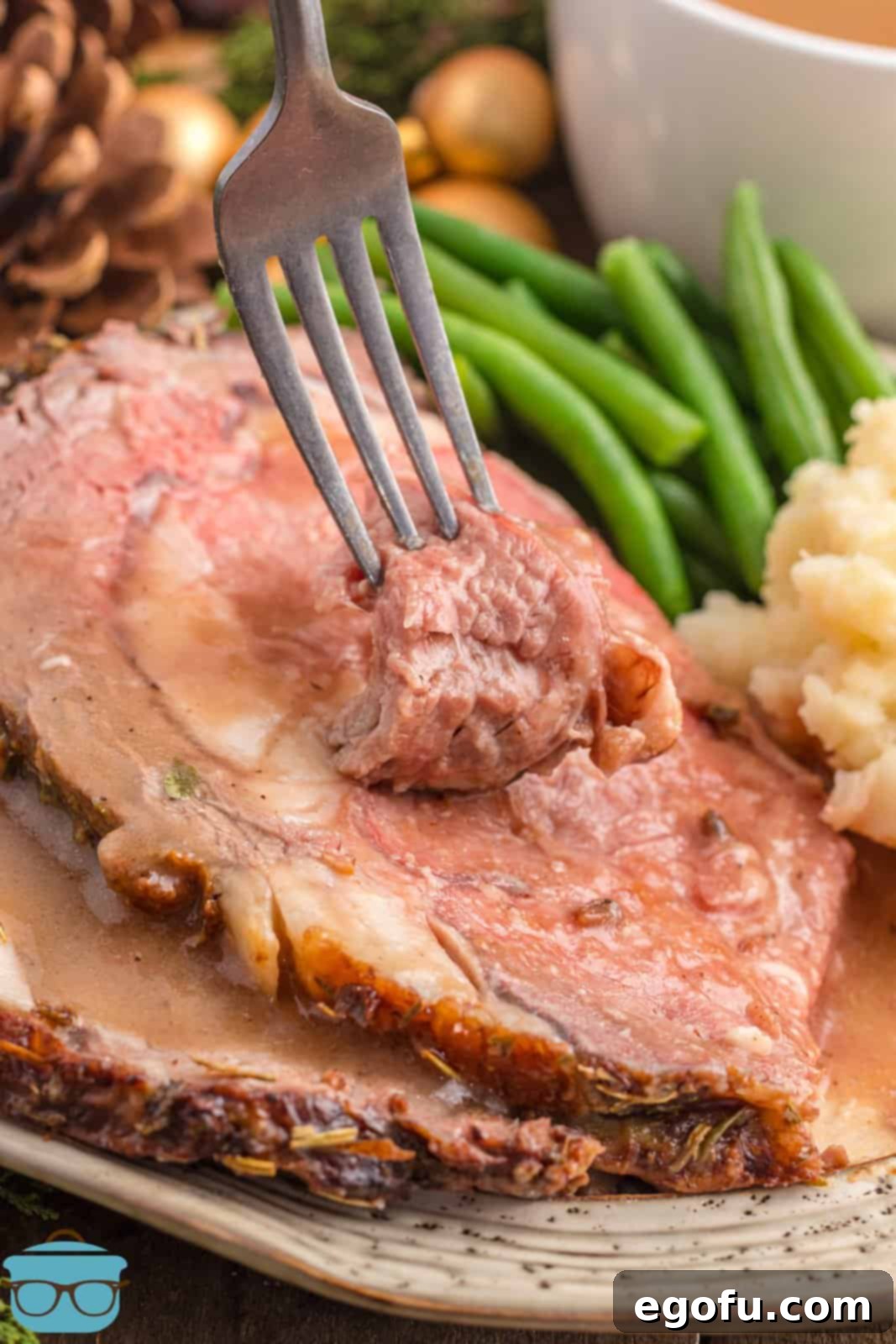
Craving More Delicious Beef & Roast Recipes?
If you’ve enjoyed mastering this incredible Garlic Butter Prime Rib, you’ll surely love exploring more of our comforting and flavorful roast recipes. Expand your culinary repertoire with these enticing options:
- Tender Oven Baked Beef Rump Roast with Brown Sugar
- Perfectly Seared Lamb Chops with Fresh Mint Pesto
- The Best Classic Roast Chicken Recipe
- Savory Instant Pot Beef Pot Roast
- Crock Pot BBQ Beef Brisket: Slow-Cooked to Perfection
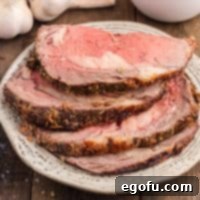
The Best Garlic Butter Prime Rib Recipe
Print Recipe
Pin Recipe
Rate This Recipe
Ingredients
- 7 pound Prime Rib Roast (bones cut and attached, my roast had 3 bones)
- ½ cup (1 stick) unsalted butter (room temperature)
- 5 cloves finely minced garlic
- 1 Tablespoon sea salt
- 1 teaspoon black pepper
- 1 teaspoon dried thyme
- 1 teaspoon dried rosemary
- 1 teaspoon dried parsley flakes
Au Jus/Gravy:
- 4 Tablespoons beef drippings (from the roast pan)
- 2 Tablespoons all-purpose flour
- 2 ¼ cups beef broth
- 1 Tablespoon Worcestershire sauce
- salt & pepper to taste
Instructions
- Remove prime rib from the refrigerator and allow it to come to room temperature for 2-3 hours. This step is crucial for even cooking.
- Once at room temperature, pat the roast thoroughly dry with paper towels. Place it in a roasting pan. Set aside while preparing the garlic butter.
- Finely mince 5 cloves of garlic on a cutting board and set aside.
- In a small bowl, combine the softened butter, minced garlic, sea salt, black pepper, thyme, rosemary, and parsley. Mix well to form a uniform herb butter paste.
- Preheat the oven to 500 degrees Fahrenheit. Using your hands or a pastry brush, apply the garlic herb butter generously to the roast, concentrating a thicker layer on top. Place the roast in the bottom third of the oven and roast for exactly 15 minutes to create a seared crust.
- After 15 minutes, remove the roast from the oven. Reduce the oven temperature to 325 degrees Fahrenheit. Insert an oven-safe probe thermometer into the thickest part of the meat, avoiding bones. Return to the oven and cook until the thermometer reaches 120 degrees Fahrenheit for a medium-rare roast (adjust for other doneness levels as per your preference).
- Allow the meat to rest, tented loosely with foil, for 20-30 minutes before carving. This crucial resting period allows juices to redistribute, resulting in a tender and flavorful roast (expect the temperature to rise another 5-10 degrees to a perfect medium-rare of around 130°F).
- While the meat rests, prepare the au jus. In a medium saucepan over medium heat, melt 4 tablespoons of beef drippings (from the roasting pan). Whisk in 2 tablespoons of all-purpose flour until thick and combined, forming a roux.
- Slowly add in 2 ¼ cups of beef broth, whisking constantly to incorporate and prevent lumps. Bring to a gentle simmer.
- Allow the au jus mixture to cook for about 5 minutes, stirring occasionally, until it thickens slightly. Remove from heat and stir in 1 tablespoon of Worcestershire sauce and season with salt and pepper to taste.
- Transfer the rested roast to a carving board. Slice against the grain into desired thickness.
- Serve your magnificent prime rib with the warm au jus and your favorite side dishes. Enjoy!
Nutrition
Carbohydrates: 3g |
Protein: 55g |
Fat: 117g |
Sodium: 1323mg |
Fiber: 1g |
Sugar: 1g
Nutritional Disclaimer
“The Country Cook” is not a dietician or nutritionist, and any nutritional information shared is an estimate. If calorie count and other nutritional values are important to you, we recommend running the ingredients through whichever online nutritional calculator you prefer. Calories and other nutritional values can vary quite a bit depending on which brands were used.
Did you make this recipe?
Share it on Instagram @thecountrycook and mention us #thecountrycook!
